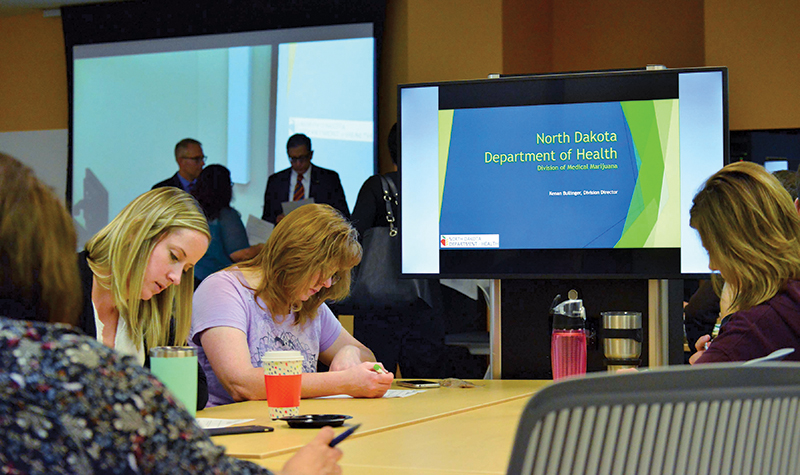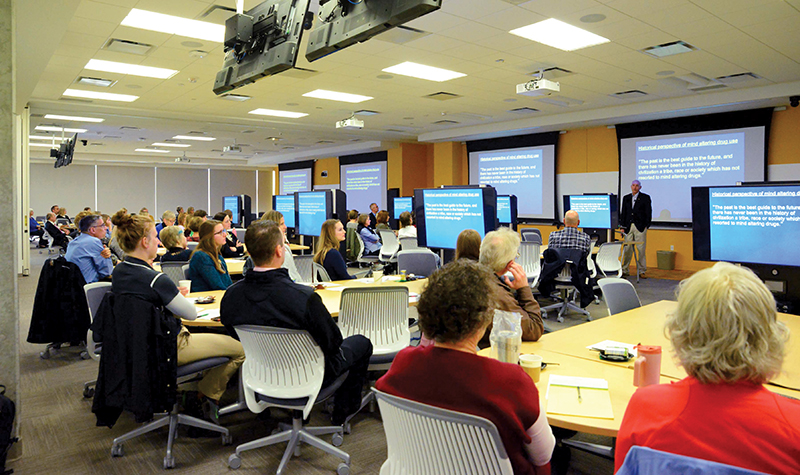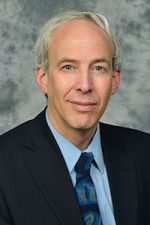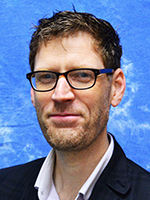15 Dec UND School of Medicine & Health Sciences office contributes to the ongoing education of thousands of North Dakota health providers each year
ar

Participants at a recent Continuing Medical Education event at the UND School of Medicine & Health Sciences. The school ‘provided nearly 15,000 continuing education hours to nearly 8,000 area health workers in 2018,’ Program Administrator Mary Johnson said. Image courtesy of the UND SMHS.
“Commit yourself to lifelong learning,” oft-quoted motivational speaker Brian Tracy once noted in a cliché repackaged as insight. “The most valuable asset you’ll ever have is your mind and what you put into it.”
Hearing such aphorisms, Mary Johnson tries hard not to roll her eyes.
As program administrator for the UND School of Medicine & Health Sciences (SMHS) Continuing Medical Education Program, Johnson knows just how much continuing education providers in North Dakota and around the country commit themselves to each year — and have been doing so decades in advance of the “lifelong learning” movement Tracy helped monetize in the 1990s.
“We provided nearly 15,000 continuing education hours to nearly 8,000 area health workers in 2018,” said Johnson of a program first accredited in 1984 and whose mission statement references specifically the lifelong learning concept. “All of that came out of the more than 300 live continuing education events we approved and the 30 online programs we managed. We do this as a service to the state and our providers, who serve us as clinical faculty for our third- and fourth-year medical students.”
In all states, professional health providers are required to do a minimum number of continuing medical education (CME) hours to maintain their licensure and/or board certification.
The average number of required hours for most physicians, for example, is 30, but some specialties require more. And although private health organizations in North Dakota are able to provide such hours for their own employees, the SMHS is the only institution in the state that provides hours to most disciplines and institutions.
Medicine’s History of Lifelong Learning
Long before CME was formalized, though, provider groups sought to increase their medical knowledge as early as the 19th century through grand rounds events and annual meetings to discuss patient cases and papers published in medical journals.
Formal continuing medical education came into being in the United States in the 1920s. The first mandatory CME program was initiated by the American Urological Association in 1934 — two decades before the American Medical Association codified CME standards for professionally trained physicians.
After some providers and patient advocates raised concerns over the fact that CME was growing increasingly reliant on pharmaceutical industry funding in the 20th century, the Accrediting Council for Continuing Medical Education (ACCME) was established in 1981.
“Hospitals can go through the [ACCME], but it’s less onerous on them to go through their state medical association,” continued Johnson. “So that’s what they do. This is why the private providers don’t offer full scope of CME services. That leaves a statewide institution like UND to pick up the slack.”
It is through the ACCME, then, that the SMHS picks up the slack, not only because it’s the right thing to do for area providers, but because such activity is embedded in the School’s mission. As section 15-52-01 of the North Dakota Century Code notes, “The primary purpose of the University of North Dakota School of Medicine and Health Sciences is to educate physicians and other health professionals for subsequent service in North Dakota and to enhance the quality of life of its people. Other purposes include the discovery of knowledge that benefits the people of this state and enhances the quality of their lives.”
An example of one such outreach is Grand Rounds, the Department of Psychiatry & Behavioral Science’s lecture series on issues in mental health. Lectures count for CME credit and occur regularly during the academic year.
On Wednesday, Dec. 18, Dr. Tracie Mallberg will present a Grand Rounds lecture, “Being Mortal — End of Life Conversations,” from 12:10 to 1:10 p.m. in the UND Medical Education Center Auditorium (Room 122), 1919 Elm Street North, Fargo, N.D. A graduate of the School of Medicine & Health Sciences and a family practice physician based in West Fargo, N.D., Mallberg is the medical director of Hospice of the Red River Valley.

This symposium on opiod use and abuse is one of the continuing education classes recently offered at the UND School of Medicine & Health Sciences. Image courtesy of the UND SMHS.
Beyond all borders

Marc Basson
“One of my professors used to joke that 20 years from now, the questions on the exam would be the same, but the answers would all be different,” added Dr. Marc Basson, the School’s senior associate dean for Medicine and Research. “Our ability to provide continuing medical education, both in person and online, allows us to fulfill our mission by helping health care providers stay up to date with medical knowledge and techniques. The online CME portfolio is particularly powerful since it allows providers to learn on their own schedule in their own homes rather than traveling to Grand Forks.”
Online courses aside, the reach of UND’s CME program extends beyond North Dakota. The office is partnering with the multi-institution Dakota Cancer Collaborative on Translational Activity (DaCCoTA) to offer training opportunities in clinical research as well. The team, which in addition to UND includes local health providers, North Dakota State University and the University of South Dakota, is funded by a $20.3 million grant from the National Institutes of Health and is designed to assemble researchers and clinicians with diverse experience from across the region to develop unique and innovative means of combating cancer in the Dakotas.
“And we’re working with the South Dakota medical association on a leadership series, providing them credits for a Health Leadership Institute,” concluded Johnson, noting that SMHS CME credit is approved worldwide. “Through our ProjectECHO program, we have an online opioid series accessible to anyone and are building another mental health CME series that will go online soon.”
Such a fact is especially important to SMHS Simulation Center Director Jon Allen, MD.
“The CME program here is accessible throughout the state, allowing those practitioners who teach medical professional students to have access to current information pertinent to clinical practice and medical education,” added Allen, whose own center relies on distance learning and “preceptors” accessing the Simulation Center at a distance.
“For physicians licensed in North Dakota, the wide variety of CME opportunities allows physicians of any specialty to find the appropriate educational events to fit their needs and meet the CME requirements for maintenance of licensure.”
About the author:



